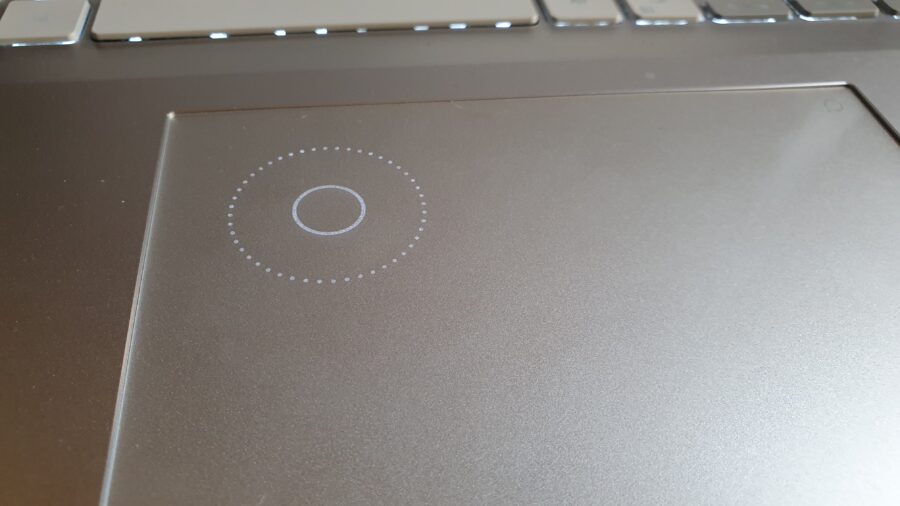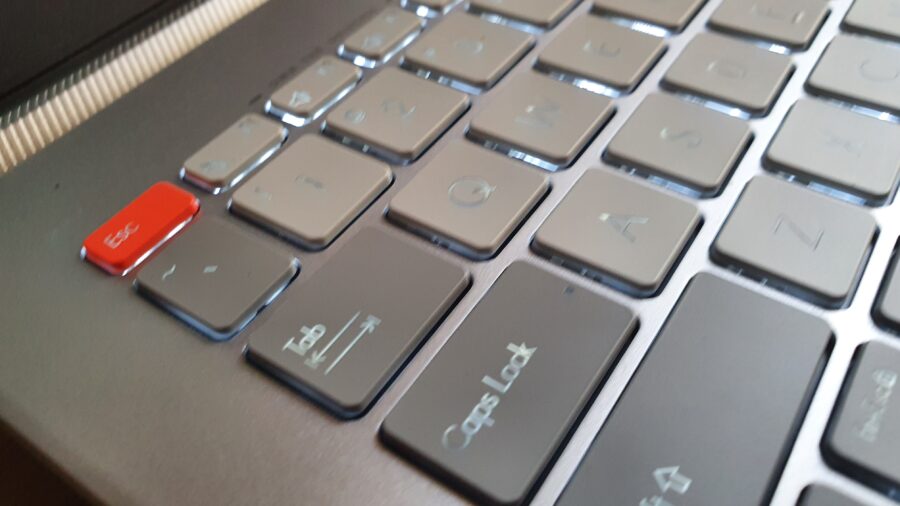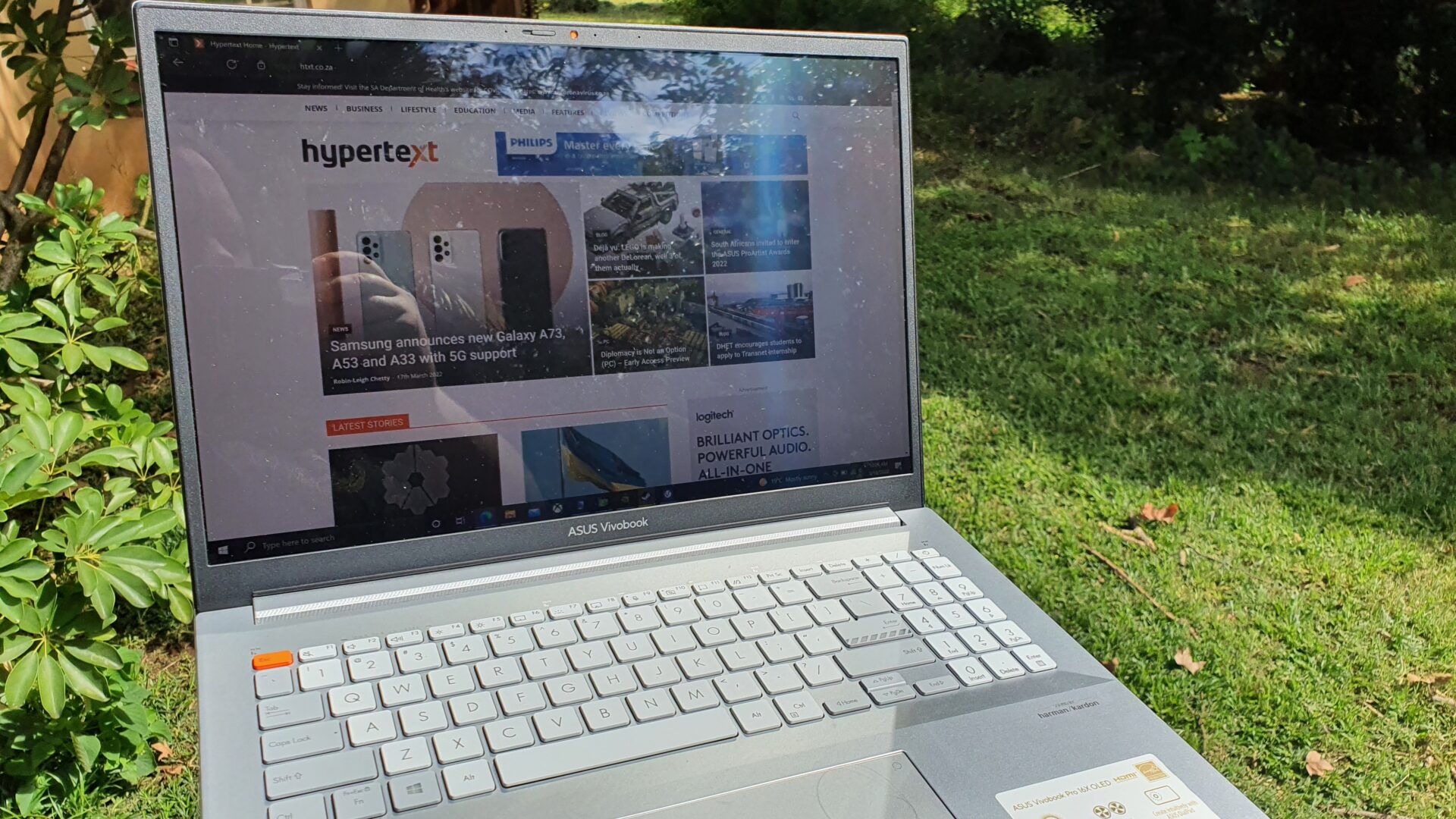Usually, our reviews here at Hypertext leave the conclusion to the end, but after two weeks with the ASUS Vivobook Pro 16X OLED, we can’t wait to talk about this notebook.
The ASUS Vivobook Pro 16X OLED is well priced with prices as low as R24 999. Not only that, the notebook is well equipped especially for those looking to do content creation whether that’s photo editing, video editing or audio production.
This review will get into the finer details, but considering the price and how well this notebook performed in our testing we see no reason to drag this on.
The ASUS Vivobook Pro16X OLED is now one of our favourite notebooks and it’s really not hard to see why from the outside.
The notebook is covered in something ASUS calls the world’s first “weave coating chassis” which looks and feels like aluminium but isn’t as prone to collecting fingerprints.
Something that does collect fingerprints is the embedded fingerprint scanner in the power button. This supports Windows Hello and it works well with scans happening nearly instantly.
The monitor is the star of the show here. Sporting a native resolution of 3840 x 2400p and a peak brightness of 550nits, the 16 inch OLED panel here is simply gorgeous to behold.
Not only is it gorgeous, it’s VESA Certified HDR True Black 500. The display also covers 100 percent of the DCI-P3 colour gamut and is Pantone validated for professional-grade colour accuracy.
The gripe we have here is the shortage of ports. With that having been said, considering this notebook is only 1.89cm thick, it’s a gripe we can live with. There a total of four USB ports (1x Type C, 2 x USB 3.2 Type A, 1 x USB 2.0 Type A) as well as one HDMI 1.4 port, a combo 3.5mm jack and a microSD card reader.
The keyboard is a treat to type on. The keys have a nice amount of travel and have a satisfying feel while typing. As far as notebook keyboards go, we wouldn’t be upset if we didn’t have an external keyboard close by.
The 720p webcam has a privacy slider that doesn’t require software to operate which is nice in this video conferencing world we find ourselves in. One of our favourite features, however, is the ASUS Dialpad.
While there is an ASUS notebook with a big chunky dial embedded into the keyboard, this iteration is digital and is accessed by swiping down in a diagonal direction from the top right of the track pad.
This Dialpad is integrated with Adobe software (specifically After Effects, Photoshop, Premiere Pro and Lightroom Classic) and using it to edit a video is a dream. Scrubbing through a timeline on a track pad is usually a chore, but the Dialpad just makes it so much easier. We’re tempted to recommend this notebook based solely on this Dialpad but, that would be unfair to how well this notebook performs.

Performance testing
Our review unit was fitted with the following hardware:
- CPU – Intel 11th Gen Core i7-11370H @ 3.31GHz.
- Memory – 16GB DDR4.
- Storage – 512GB M.2 NVMe SSD.
- GPU – Nvidia RTX 3050 Laptop.
In our testing we achieved a score of 10 299pts in Cinebench R23 multi-core which is respectable.
During our testing the CPU reached an eye watering 95 degrees celsius which means that for longer editing sessions, you may want to opt for an external keyboard. For short stints, the heat isn’t uncomfortable, but it is noticeable.
Testing the GPU performance required us to switch between Nvidia Studio Drivers and Nvidia Game Ready Drivers. This notebook ships with the Studio drivers installed as this is a notebook for creative applications. The difference between the two drivers is very minute as you’ll see below, but really, this notebook isn’t meant for gaming. You can absolutely play games, but it’s just not what it’s designed for and you’d be better buying a gaming notebook if that’s your intended use case.
Using V-ray’s CUDA benchmark we achieved a score of 456 vpaths with the Studio Drivers installed and 448 vpaths when we used Game Ready Drivers.
Rendering a two minute FullHD video for publication on YouTube took roughly a minute with either driver installed. We advise sticking with the Studio driver if you are using creative applications.
In terms of GPU temperatures, we never saw anything over 85 degrees Celsius which is great news, but the overall system does get warm
Okay fine, we’ll take a moment to look at gaming.
Running 3DMark’s TimeSpy we recorded a score of 5 318 with an average frame rate of 25fps. When we switched to TimeSpy Extreme, a benchmark for 4K gaming, the benchmark crashed consistently during the first test.
As we said, you’re better off buying a notebook purpose built for gaming.
While using this notebook to edit video, we were impressed at how quickly elements of Adobe Premiere Pro loaded in, how effortless it was scrubbing through our timeline and also just how quick encoding and exporting was. While it’s not on the level of a desktop with a gargantuan GPU, as a mobile editing station the Vivobook Pro 16X OLED is fantastic.

Battery
Despite being as thin as it is and weighing less than 2kgs, the Vivobook Pro 16X OLED is rocking a 96WHr lithium-ion battery.
In our testing we observed an average battery life of 3 hours and 40 minutes while using the notebook to work on documents, edit photos and streaming content. If all you do is stream content and you switch to a less power hungry power profile in Windows, you can eke out an extra 20 or so minutes to bring the battery life up to four hours and 10 minutes.

Conclusion
With prices as low as R24 999 for the iteration we tested, the ASUS Vivobook Pro 16X OLED is the perfect tool for creators on the go or those just starting out.
While we have tested notebooks that outperform this notebook, from our own experience using the Vivobook Pro 16X OLED for content creation, it’s fantastic especially for the use cases above.
We don’t like the 4K display because as we’ve lamented in the past, 4K on a 16inch display such as this means the minute details are lost on you unless you’re inches from the display. Other than that, the battery life is in line with other notebooks with this spec, the performance is decent and we really can’t find fault here.
We can absolutely give the ASUS Vivobook Pro 16X OLED a recommendation for those looking to be more productive while away from their primary editing station or those looking to start editing video and the like.
Great job ASUS, we’re sad we have to give this notebook back.



